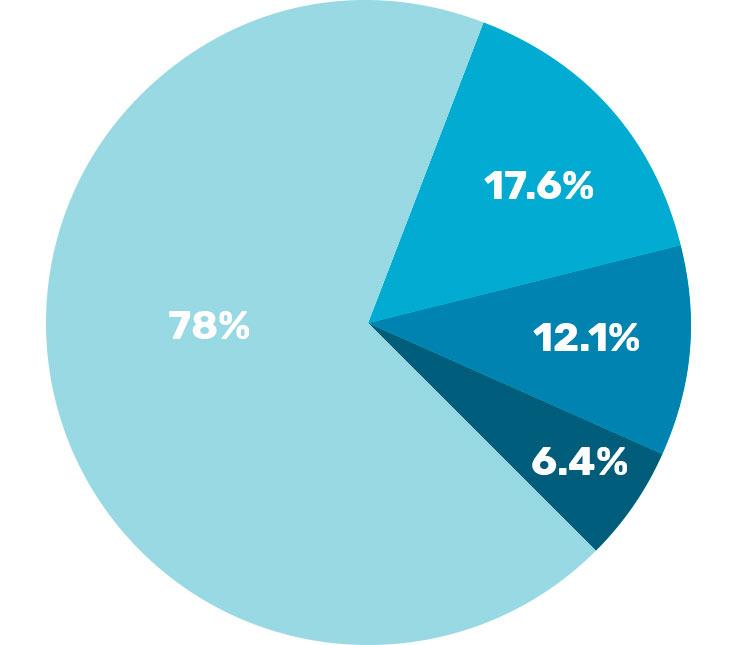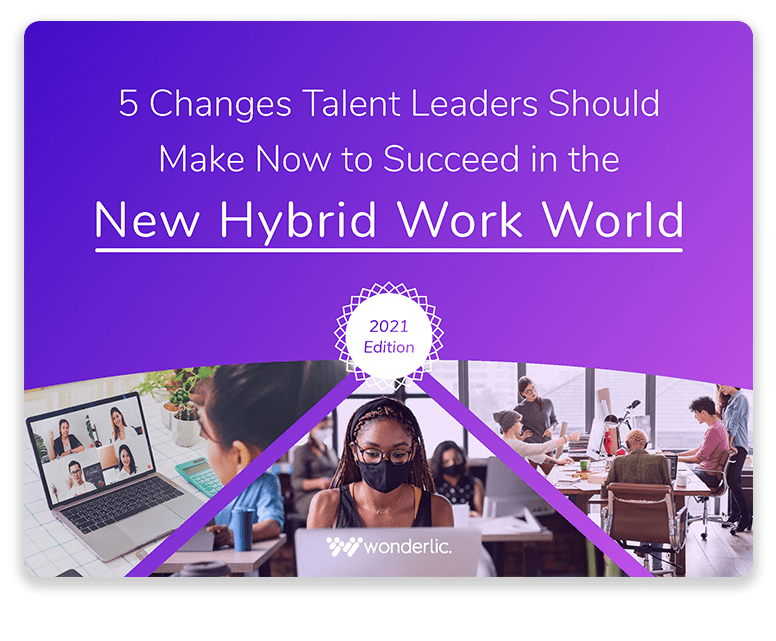It’s no secret that diversity, equity, and inclusion standards are becoming increasingly important to companies. In fact, a recent Fortune 500 survey shows 75% of responding companies have a diversity program in place.
Unfortunately, despite the emphasis on diversity, the hiring process is still rife with bias that negatively impacts marginalized candidates and hurts employers’ chances of finding the best candidate for the job.
Sensitivity training and one-day seminars aren’t enough: companies also need to have a consistent strategy in place to combat bias during the hiring process. Here’s what you can you do to create fair and unbiased hiring practices:
Table of Contents
8 Ways to Reduce Bias in Hiring
What Is Unconscious Bias?
The Effects of Reducing Hiring Bias and Increasing Diversity
Unbiased Hiring Success Stories
Additional Resources
8 Ways to Reduce Bias in Hiring
Acknowledge the problem
You can’t establish unbiased hiring practices until you acknowledge that unconscious bias is a problem nationwide and very likely a problem at your company.
Here’s the breakdown for race/ethnicity according to labor force statistics from a current population survey:

- 78 percent of the workforce is White
- 17.6 percent is Hispanic or Latino
- 12.1 percent is Black
- 6.4 percent is Asian
To create a more equitable hiring process, assess the ethnicity breakdown at your company and compare it to national or regional averages. The United States Census Bureau site is a good starting point for this research.
Assess job descriptions
Even the most minute details in your job description can impact the diversity of your applicant pool. Research shows that words like “competitive” and “determined” often attract more male applicants, while words like “collaborative” and “cooperative” often result in more female applicants.
To combat this bias, use software like Gender Decoder that highlights gendered language and then replace or remove the words. Ongig’s Diversity Text Analyzer identifies “exclusionary phrases” related to ethnicity, primary/secondary language, and immigration status—and provides neutral alternative phrases.
Adjust your advertising
With so many roles being work-from-home these days, your potential candidate pool is practically limitless…unless it’s limited by bias.
If you don’t have a diverse candidate pool, diversity goals are doomed from the start. Where you focus your recruitment efforts matters.
Consider branching out by:
- Looking beyond industry-specific sites and groups to bypass your industry’s unconscious biases.
- Adjusting search parameters to include those with strong transferable skills. (This will benefit candidates who might have been denied work experience or a job title in environments or industries rife with bias.)
- Using job boards for minority candidates (like Diversity.com and PDN Recruits).
- Expanding your university recruiting to include schools with diverse student bodies. (Research by LinkedIn shows that only 28 percent of companies make that a priority.)
Conduct blind resume reviews
According to a landmark study by Betrand and Mullainathan, resumes with Black-sounding names experience a 50% callback gap when compared to resumes with white-sounding names. You can opt for blind resume reviews by using software to remove names. This process helps ensure you’re picking from the most relevant candidates based on experience without the influence of unconscious bias.
Here’s how it works:
- First, you’ll need to choose the demographic information to hide. This could include identifiers like name, zip code, headshots, and any other demographic information that could result in hiring bias and occurs during the pre-screening process.
- Next, you’ll hide this information. You can use software to do this (like Pinpoint ) or you can have someone not involved in hiring decisions filter out the information before you see the applications.
- Once identifiers are removed, use experience, skills, and hiring assessments to choose your front-runners.
- Reveal the identity of your candidates when it’s time to conduct interviews.
Help hiring teams steer clear of interview biases
Consider educating your team through unconscious bias interview training. With this awareness, you have a better chance of forming unbiased hiring practices. (More information on the most common types of interview bias is in the next section.)
Opt for structured interviews
In structured interviews, hiring teams ask every candidate the same set of questions and judge performance consistently based on pre-set criteria. This creates a level playing field by giving every candidate an equal opportunity to show they’re right for the job.
It also reduces bias by keeping interview questions on track and on topic, only addressing factors that will impact job performance. By comparison, unstructured interviews are more susceptible to interviewer biases relating to gender, race, and disability when content unrelated to the job is discussed.
Also, studies show that structured interviews reveal 26 percent of a potential employee’s performance (with unstructured interviews revealing only 14 percent), indicating that they are more effective at identifying potential hires suited to the role than unstructured interviews.
Use best-in-class hiring assessments
Asking candidates to take a hiring assessment is another way to mitigate the unconscious bias found in the resume screening and interview process. Hiring assessment results can be instrumental in narrowing down a candidate pool by revealing which candidates are right for the job based on objective traits like cognitive ability, motivation and personality. You can also use insights from assessments to help make final hiring decisions post-interview.
See how employers can use assessments like WonScore at every stage of the hiring process to help them objectively identify the highest-potential candidates.
Create a diverse employee referral program
Don’t overlook company policy as a valuable tool against hiring bias. Data shows that referrals disproportionately benefit white men. They receive 40 percent of referrals, while white women receive 30 percent, men of color receive 17 percent, and women of color receive 13 percent.
Combat this problem by creating minimum requirements for underrepresented individuals in the final candidate pool and by implementing an employee referral program that encourages employees to refer minority candidates.
A diversity referral success story
When Intel devoted $300 million to their diversity mission, a portion of that budget went to improving their referral program. They created a separate referral program just for hiring women, minorities, and veterans. They then set a goal to increase diversity hires by 14 percent. They worked toward this goal by doubling their referral bonus from $2,000 to $4,000, promoting the diversity program both publicly and in-house, and simplifying the referral program with technology. Ultimately, they increased diversity hires by 44 percent.

What Is Unconscious Bias?
Unconscious bias (also known as implicit bias) is the act of unknowingly making prejudiced judgments. Biased hiring skews the hiring process, often unfairly excluding more qualified candidates.
Awareness and education are crucial in preventing unconscious bias. Here are some types of unconscious bias that often skew the hiring process:
Confirmation bias
Confirmation bias is the tendency to look for information that confirms your first impression of a candidate, and to unconsciously dismiss evidence to the contrary. For example, a recruiter might have had a positive interaction with a candidate on a phone screen, and during the candidate’s interview, only focus on aspects that confirm her first-blush assessment of the candidate as a result.
Affect heuristics
Affect heuristics describes the mental shortcuts people take to decide whether or not a candidate is appropriate for a job, without first considering evidence. For example, a hiring manager might unconsciously disqualify a person because he has tattoos or is overweight.
Halo effect
Halo effect bias occurs when a person puts a candidate on a pedestal after learning one impressive fact about them. This bias can flare up at any point in the hiring process. If a candidate mentions that he worked at a well-regarded company or attended a prestigious school, he might experience an advantage unrelated to merit.
Horn effect
This is the opposite of the halo effect—when someone immediately discounts a candidate because of a single piece of information they perceive as negative.
Contrast bias
In a hiring context, this describes when members of a hiring team compare interviewees or résumés to each other instead of objectively comparing everyone to the job description or standard.
Affinity bias
Affinity bias (aka similarity bias) is the tendency to connect with people who have similar interests and backgrounds. While this sometimes indicates the candidate will be a “culture fit” and get along with the team, it carries no weight in their potential job performance.
Conformity bias
Conformity bias (commonly known as peer pressure) describes the tendency of a person to take on the opinions of others with no regard for their personal beliefs. This becomes an issue when a hiring team collaborates to discuss application materials. Conformity bias can cause members of the team to side with the majority because that seems like the safe thing to do.

The Effects of Reducing Hiring Bias and Increasing Diversity
Tackling your bias problems is the right thing to do—but it can also lead to positive business outcomes.
Improve your recruiting efforts
You might not realize the impact diversity has on your recruiting efforts. According to a Glassdoor survey, 2 out of 3 job seekers evaluate potential positions based on the company’s diversity. This is especially important if you’re looking to hire millennials and Gen Zs, as workplace diversity is especially important to these demographic groups.
Boost your retention rates
Diversity can also impact retention rates. According to HR expert Ruth Mayhew, diversity often results in:
- An environment of mutual respect
- Marginalized groups gaining economic power
- Conflict reduction
- Enhanced business reputation and opportunity
- Globalization opportunities
- A workplace where employees learn from each other
All of these benefits positively impact retention. Lack of diversity can lead to increased attrition because of marginalized employees who don’t feel welcome and bystanders bothered by the inequities they observe.
Increase productivity and sales
According to a study by McKinsey & Company, gender diverse teams are 15% more productive and ethnically diverse teams are 35% more productive when compared to non-diverse teams.
Additionally, research shows that with every 1 percent increase in the rates of gender and cultural diversity, companies experience a 3 percent and 9 percent rise in sales, respectively.

Unbiased Hiring Success Stories
Here are a few examples of companies that have successfully implemented unbiased hiring practices:
Tarrant County Information Technology Department
When Chris Nchopa-Ayafor, CIO of Tarrant County, Texas started overseeing the county’s Information Technology Department, he noticed that the organization did not reflect the diversity of the community. After assessing his department and observing the diversity at a nearby organization, he took some steps to change that:
- He replaced one-on-one interviews with diverse panels and implemented a consistent process with structured interviews.
- He introduced entry-level positions and internships to grow talent through mentorship and coaching to emphasize potential and hard work rather than previous experience.
- Finally, he created a unified database for collecting candidate information as a way to level the playing field for all candidates.
Science Applications International Corporation (SAIC)
SAIC is boosting diversity in the workplace by adjusting where they’re looking for candidates. To do this, they’re using software created by in-house software developers to locate diverse talent (including passive candidates). They’ve also trained their recruiting team to write more inclusive job descriptions.
LightSpeedEdu
Carlton Oneal and his wife Brenda founded LightSpeedEdu. It’s a boutique education technology company that strongly values a diverse environment.
Carlton always insisted on being defined by his accomplishments rather than his being Black. He climbed the corporate ladder until he was denied a senior-level position because the hiring executive’s felt “more comfortable” with another candidate.
This experience inspired Carlton’s passion for eliminating hiring bias in the workplace. To avoid hiring bias and create more diversity at his company, Carlton contracts with minority businesses. He believes diversifying the supply chain creates economic opportunities and motivates companies to include diverse suppliers in all bids.
He also places a strong emphasis on diverse leadership, especially in the boardroom. Giving junior employees diverse role models is inspiring, and it also helps ensure that hiring decisions are based on skills and performance.
Additional Resources
CEO Action for Diversity and Inclusion
Access resources like a list of affinity groups and networks, as well as discussion guides, podcasts, and quizzes about DE&I.
Google’s People Analytics Team
Google’s People Analytics team offers comprehensive resources on how to fight hiring bias. It includes 7 modules filled with videos, articles, and downloadable worksheets.
Managing Unconscious Bias by Facebook
Facebook released a series of 7 videos on combating common workplace biases. The videos are about 15 minutes each and provide context on stereotypes and performance bias, performance attribution bias, competence/likability tradeoff bias, maternal bias, along with actions you can take.
LinkedIn’s 2020 Workforce Diversity Report
LinkedIn’s diversity report provides valuable information on diversity and inclusion trends. You can use this resource to see how your company’s diversity compares to norms and to learn how LinkedIn is combating hiring bias.
Google Diversity Annual Report 2020
Google’s diversity report is a great resource for learning how to make your business more diverse, inclusive, and accessible. In the report, you can find statistics on workforce representation, hiring bias, retention, leadership representation, and much more.
Does your recruiting team feel prepared for the murky post-vaccine job market ahead?









